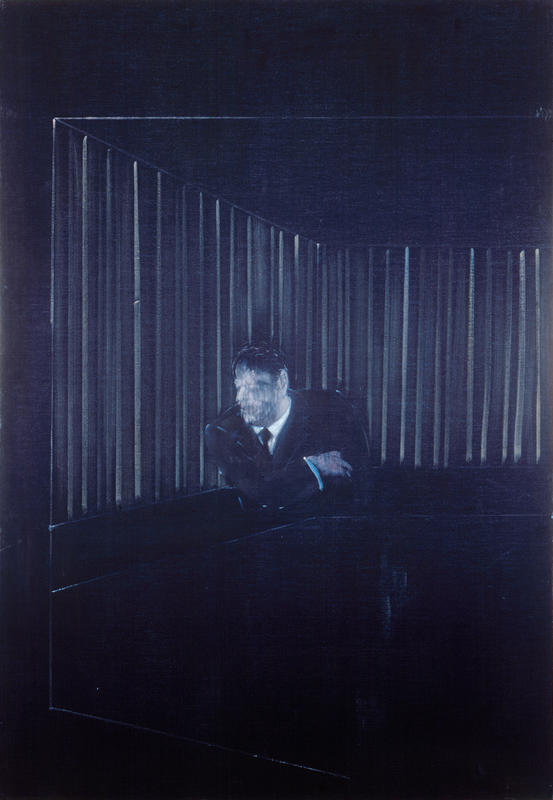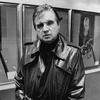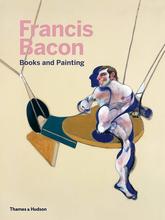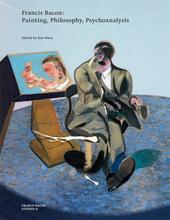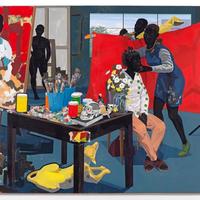More about Man in Blue I
- All
- Info
- Shop

Contributor
Francis Bacon was a weird dude.
However, he also lived in complicated and strange times: the Cold War was raging, hippies abounded, sexuality was a hot topic. He was gay at a time in which it was illegal, and often found himself in abusive and complicated relationships with his lovers. In a way, the drama and facelessness - the heavy darkness of Man in Blue I - captures Bacon’s own troubled life.
This is the first of seven Man in Blue paintings. This first painting sets the scene for the series: we find our hero alone at the bar. He doesn’t sexily cradle a martini, but instead holds himself. His face is a swipe of paint, the features indistinguishable against the cell-like background. The setting: the Imperial Hotel, Henley-on-Thames in Oxfordshire, England. Conflict: literal conflict - Bacon had run away from his abusive then-partner, Peter Lacy. However, he would return. Bacon referred to Lacy as the love of his life, saying that “being in love in that extreme way - being totally, physically obsessed by someone - is like having some dreadful disease. I wouldn't wish it on my worst enemy.” Knowing this, it is more difficult to tell if we are in the midst of a seduction. Is Bacon out cruising? Is he scared of this man? The tension in the piece is palpable.
Over the next six paintings there is no resolution: the same mysterious subject is depicted at different angles and distances - sometimes looking out from the canvas, once even checking his watch as if bored of being looked at. It is a refreshing change from Bacon’s typical screaming heads. Oh, by the way - the subject is still anonymous, so no one really knows what the relationship was between Bacon and this blue sitter beyond that of model and artist.
What remains consistent across the Man in Blue series is the distinctive blue palette. Is this a melancholic scene? Is it malicious? The darkness adds intrigue and perhaps a sadness to the work. The other familiar feature is the background: those curtains, or cell bars, or lights - whatever they are. Bacon referred to this feature as “shuttering.” While it shutters the literal setting, it certainly opens up the painting to the imagination of the viewer, giving us free reign to imagine a smoky bar and what might take place there.
Bottom line: the mysterious and sexy stranger that Bacon painted in the group of Man in Blue works, while unknown, certainly cannot be mistaken for a member of the quirky Blue Man Group.
Sources
- “Biography: 1950s.” FrancisBacon.com, accessed 19 August 2019, https://www.francis-bacon.com/life/biography/1950s.
- “Francis Bacon's "Man in Blue VI" Leads Christie's Auction of Post-War and Contemporary Art.” artdaily.com, accessed 19 August 2019, http://artdaily.com/news/28428/Francis-Bacon-s--Man-in-Blue-VI--Leads-C…
- Jones, Jonathan. “The beast within.” The Guardian, 5 August 2009, accessed 19 August 2019, https://www.theguardian.com/culture/2005/aug/09/edinburghfestival2005.e….
- Laster, Paul. “Art’s Obsessive Genius.” the daily beast, 7/14/17, accessed 9/19/19, https://www.thedailybeast.com/arts-obsessive-genius.
- “Man in Blue I.” Boijmans. Accessed 19 August 2019, https://www.boijmans.nl/en/collection/artworks/3823/Man-in-blue-I-%2FFr….
- Salter, Gregory. “Francis Bacon and Queer Intimacy in Post-War London.” Taylor and Francis Online, 10 April 2017, accessed 19 August 2019, https://www.tandfonline.com/doi/abs/10.1080/14714787.2017.1302817?needA….
- Stanska, Zuzanna. “A Study of Loneliness and Isolation: The Man in Blue.” Daily Art Magazine, 20 May 2018, accessed 19 August 2019, https://www.dailyartmagazine.com/man-in-blue-by-francis-bacon/.

